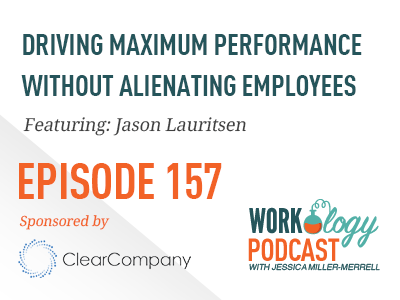The economy is strong and companies are working hard to ride the bull markets. That means taking the bull by the horns and focusing on driving maximum performance, revenue, and profitability. That’s easier than it sounds. Employee engagement, retention, and recruiting are at the forefront of creating a high-performance culture. The real question is: What’s the recipe for successfully getting the most out of your employees without driving them away?
Episode 157: Driving Maximum Performance in Your Workplace Without Alienating Your Employees with Jason Lauritsen (@JasonLauritsen)
Today, I’m joined by Jason Lauritsen. He’s a self-described corporate executive gone rogue who speaks on a wide variety of topics around performance, engagement, and leadership. He’s also the author of a new book, Unlocking High Performance. Jason believes that work as we know it is broken. There is not only a disconnect between employers and employees, but a disconnect between employers who treat work as a contract, and employees who experience work as a relationship. It’s causing a disconnect that is impacting the performance, engagement, training, and retention of those same employees.
Jason’s new book talks about how to find alignment between high performance and performance management. It covers a lot of ground and in my interview with Jason, we cover topics like employee experience, employee reviews, and workplace accountability. When it comes to the employee experience, Jason says it’s important to have clarity in terms of your expectations, making sure that your employees understand the very specific job and behavioral expectations they are expected to work within and from. He says the key is to make sure we’re recognizing and appreciating employees. He says there are some basics, and he tries to help people understand that these are important no matter what kind of employee you have or where you’re at.
High-Performance Recipes For Success
I am a fan of analogies, and Jason uses a cookbook analogy to frame much of his book. He talks about how you have foundational parts of a meal like vegetables, proteins, and dessert, but the meal you end up cooking is really unique to your individual tastes and preferences. This is the same when it comes to engaging and driving performance in your teams and within your organizations.
This workplace performance cookbook that Jason has put together gives organizations options to plug in and customize their own programs and plans, but still provides a solid framework for them to work within. He provides a number of case studies and examples from different organizations that readers can draw and pull from.
Jason’s performance management system has three components:
1. Planning
2. Cultivation
3. Accountability
He says planning is really about expectation clarity. This is clarity of goals, objectives, and behavioral expectations — really understanding the why and how of your job. Cultivation is a piece that he thinks is often missed. Here, he takes a nod from farmers and farms, where plants must be fostered and cultivated. In the context of a workplace, it is culture and employees that need to be cultivated. The third component — accountability — is predominately about feedback and measurement. Jason says that, within accountability, there’s also a component of reflection. This allows people to put themselves in a position where they can reflect on their own contributions to performance, and make decisions about how they want to improve going forward.
Jason’s approach sounds so simple, but you and I know that creating a high-performance company and culture is not an easy task. Grab a copy of his new book. It’s packed full of great insights and best practices that will have you and your organization humming along at optimal performance in no time, or will at least give you a clear path and recipe for success.
Connect with Jason Lauritsen.
RECOMMENDED RESOURCES
-
- Unlocking High Performance ~Jason’s book
How to Subscribe to the Workology Podcast
You can also click here to find out how to be a guest on the Workology Podcast.
*A special thank you to my production team at Total Picture Radio.









2 Comments
This is awesome, Jessica, thanks for sharing! I love the three elements of Jason’s framework and how they seamlessly flow from one to the other – super helpful! We talk about trying to foster a culture of clarity at Lessonly and are constantly encouraging managers and employees alike to both seek and provide clarity. Since we’ve really had a focus on this (for about 9 months), the results are amazing. I feel a sense of greater confidence than ever before and we’re performing even better as a team with regard to business KPIs. Anyway, I’m not sure if that’s helpful, but count me in as another vote for the three-part recipe from Jason!
Great article Jessica.
Having read it through (twice) the thought that keeps going through my head is ‘do the ingredients, or even the cookbook, alter depending on the size of a company?
I ask because our own business has been through a big change over the last year or so, almost doubling in sizer. Over that time, sitting in my little booth, watching the newcomers arrive and the behaviour of staff, managers etc, I notice behaviours change.
So my question is, to what extent does size impact on a group dynamic and influence attitudes, company goals and even the words or phrases shared by a team?
In your opinion, at what point – and there surely comes a point – does the dynamic change?
Comments are closed.